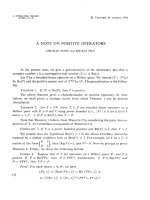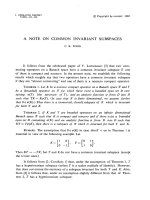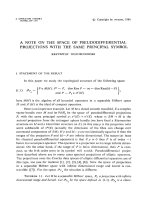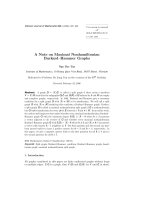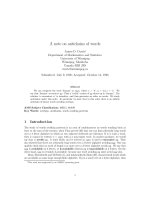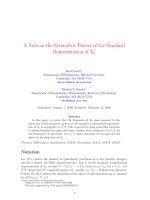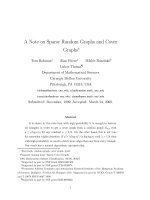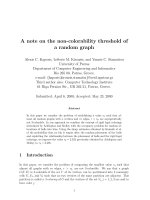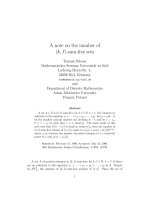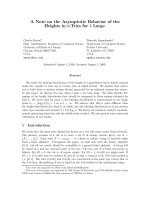Báo cáo toán học: " A note on edge-colourings avoiding rainbow K4 and monochromatic Km" doc
Bạn đang xem bản rút gọn của tài liệu. Xem và tải ngay bản đầy đủ của tài liệu tại đây (117.44 KB, 9 trang )
A note on edge-colourings avoiding rainbow K
4
and monochromatic K
m
Veselin Jungi´c
1
Tom´aˇs Kaiser
2∗
Daniel Kr´al’
3∗
Submitted: Feb 10, 2009; Accepted: May 28, 2009; Published: Jun 12, 2009
Mathematics Subject Classification: 05C55
Abstract
We study the mixed Ramsey number maxR(n, K
m
, K
r
), defined as the
maximum number of colours in an edge-colou ring of the complete graph
K
n
, such th at K
n
has no monochromatic complete subgraph on m ver-
tices and no rainbow complete subgraph on r vertices. Improving an up-
per boun d of Axenovich and Iverson, we show that maxR(n, K
m
, K
4
) ≤
n
3/2
√
2m for all m ≥ 3. Further, we discuss a possible way to improve
their lower bound on maxR(n, K
4
, K
4
) based on incidence graphs of finite
projective planes.
1 Introduction
A subgraph of an edge-coloured graph is monochromatic if all of its edges receive
the same colour, and it is rainbow if all the edge colours are distinct. Ramsey
theory was born with the observation that every sufficiently large complete gra ph
whose edges are coloured by k colours, where k is a fixed integer, contains a
large monochromatic complete subgraph [15 , 8]. In the following decades, it
1
Department of Mathematics, Simon Fraser University, Burnaby, B .C., V5A 2R6, Canada.
E-mail:
2
Department of Mathematics and Institute for Theoretical Computer Science, University of
West Bohemia, Univerzitn´ı 8, 306 14 Plzeˇn, Czech Republic. E -mail:
Supported by Research Plan MSM 4977751301 of the Czech Ministry of Education.
3
Institute for Theoretical Computer Science (ITI), Faculty of Mathematics and Phys-
ics, Charles University, Malostransk´e n´amˇest´ı 25, 118 00 Pra gue, Czech Republic. E-mail:
∗
The Institute for Theoretical Computer Science (ITI) is supported by project 1M0545 of
the Czech Ministry of Education.
the electronic journal of combinatorics 16 (2009), #N19 1
evolved into a rich part of graph theory with strong links to combinatorial number
theory [13] and combinator ia l geometry (see, e.g., [14]). There are many Ramsey-
type problems that involve monochromatic substructures of various combinatorial
structures, but some are of a different type.
Among them is the question asked by Erd˝os, Simonovits and S´os [7]: Given a
graph H and an integer n, what is the maximum number of colours in an edge-
colouring of a complete graph K
n
such that no copy of H in K
n
is rainbow? This
number is the anti-Ramsey number (for H and n) (see also [1 1, 12]).
As a combination of the two problems, Axenovich and Iverson [1] defined
the mixed Ramsey numbers maxR(n, G, H) and minR(n, G, H) as the maximum
(resp ectively, minimum) number of colours in an edge-colouring of K
n
such that
no monochromatic subgraph of K
n
is isomorphic to G and no rainbow subgraph
is isomorphic to H. They noted that the numbers are well-defined whenever
the edges of G do not induce a star and H is not a forest (see also [9]). Their
results asymptotically determine the behaviour of maxR(n, G, H) in most cases
and exhibit a close relation between this number and the vertex arboricity a(H)
of H, defined as the least number of parts in a decomposition of V (H) into sets
inducing acyclic subgraphs of H.
In the present paper, we will be concerned with bounds on maxR(n, K
m
, K
4
)
for m ≥ 3. Let us briefly recall some of the results of [1] related to maxR(n, G, H).
Assume that the edges of G do not induce a star. If a(H) is at least 3, then
maxR(n, G, H) is quadratic in n, namely
maxR(n, G, H) =
n
2
2
1 −
1
a(H) −1
(1 + o(1 ) ).
On the other hand, if a(H) = 2, then maxR(n, G, H) is subquadratic:
maxR(n, G, H) = O (n
2−
1
ǫ
),
for some ǫ which depends on G and H. There exists a more explicit upper bound
if V (H) can be decomposed into two sets inducing forests, one of which is of
order at most 2. In this case,
maxR(n, G, H) ≤ n
5/3
(1 + o(1 ) ). (1)
In the special case that H is a cycle, maxR(n, G, H) can be determined for non-
bipartite graphs G:
maxR(n, G, C
k
) = n
k −2
2
+
1
k − 1
+ O(1 ).
As for the lower bounds, Axenovich and Iverson [1] prove that if G is non-bipartite
and the minimum degree of H is at least 3, then
maxR(n, G, H) ≥ n log n. (2)
the electronic journal of combinatorics 16 (2009), #N19 2
If we restrict to the case where G and H are complete graphs, the above results
asymptotically determine maxR(n, G, H) in all cases except H = K
4
, where we
only have the bounds (1) and (2). In particular, the problem of determining
maxR(n, K
4
, K
4
) is referred to in [1] as ‘one of the most intriguing’ in this area.
The purpose of this note is to improve the upper bound on maxR(n, K
m
, K
4
)
for all m ≥ 3:
Theorem 1.
maxR(n, K
m
, K
4
) ≤ n
3/2
√
2m.
We prove this bound in Section 2. In Section 3, we discuss a possible way
to improve the lower bound (for m = 4) ba sed on incidence graphs of finite
projective planes, and present some open problems.
2 The upper bound
Let m ≥ 3 be a fixed integer throughout this section. Let us call an edge-colouring
of a complete graph K
n
admissible if K
n
has no monochromatic complete sub-
graph on m vertices and no rainbow complete subgraph on 4 vertices. For an
admissible edge-colouring c of K
n
and disjoint sets A, B ⊂ V (K
n
), we define
S
c
(A, B) as the set of colours that are used by c, but only on edges joining A to
B. Furthermore, we set σ
c
(A, B) = |S
c
(A, B)|.
To prove the following lemma, one could use a suitable version of the Zaran-
kiewicz theorem (e.g., that in [10, Exercise 2.6]). For the reader’s convenience,
we give a self-contained proof.
Lemma 2. Let c be an admissible edge-colouring of K
n
and A, B disjoint subsets
of V (K
n
) each of size at most k. Then
σ
c
(A, B) ≤ k
3/2
√
m.
Proof. For each colour s ∈ S
c
(A, B), choose an edge of colour s and let Y be the
set of all chosen edges. Define H to be the spanning subgraph of K
n
with edge
set Y . Observe that |Y | = σ
c
(A, B). We claim that every two vertices x, y ∈ B
have fewer than m common neighbors in the graph H.
For any two vertices x, y ∈ B, let A
xy
be the set of common neighbours of
x a nd y in the graph H. Consider z
1
, z
2
∈ A
xy
. By the definition of H and
S
c
(A, B), no edge of H has colour c(xy) or c(z
1
z
2
). Since the induced subgraph
of K
n
on {x, y, z
1
, z
2
} is not rainbow, we must have c(xy) = c(z
1
z
2
). But then all
the edges on A
xy
have colour c(xy). Since G contains no monochromatic complete
subgraph of order m, we have |A
xy
| ≤ m −1 for every x, y ∈ B.
Let N be the number of all triples xyz with x, y ∈ B and z ∈ A
xy
. By the
above,
N ≤ (m −1)
|B|
2
.
the electronic journal of combinatorics 16 (2009), #N19 3
On the other hand, if we set d
1
, . . . , d
ℓ
to be the degrees of the vertices in A in
the graph H (ℓ = |A|), we find that N equals the sum of
d
i
2
and therefore
ℓ
i=1
d
i
2
≤ (m −1)
k
2
. (3)
Since the function f(x) = x(x−1)/2 is convex, we may use Jensen’s inequality
to derive
ℓ
i=1
d
i
2
≥ ℓ ·
(
ℓ
i=1
d
i
)/ℓ ·((
ℓ
i=1
d
i
)/ℓ −1)
2
.
Observing that the sum of the d
i
is |Y | and combining with (3), we obtain
|Y |(|Y |− ℓ) ≤ k(k − 1)(m − 1)ℓ.
Furthermore, ℓ may be replaced with k on both sides of the inequality as ℓ ≤ k.
This leads to the following quadratic inequality in |Y |:
|Y |
2
− k |Y | −k
2
(k − 1)(m −1) ≤ 0. (4)
Solving (4), we find
|Y | ≤ k ·
1 +
1 + 4(k −1 )(m − 1)
2
. (5)
The fraction in the right hand side of (5) is easily seen to be at most
√
km by
a direct calculation, so |Y | ≤ k
3/2
√
m and the statement of the lemma is true.
It is now easy to derive our upper bo und o n maxR(n, K
m
, K
4
):
Proof of Theorem 1. We proceed by induction on n. It is easy to check that for
n ≤ 21,
n
2
is less than n
3/2
√
2m for m ≥ 3, so we may assume that n ≥ 22. Set
α = (1 + 1/22)
3/2
and note that (n + 1)
3/2
≤ αn
3/2
.
Let c be an admissible colouring of K
n
. Fo r X ⊂ V (K
n
), define ℓ(X) as
the number of colours used for edges on X. We need to prove that ℓ(V (K
n
)) ≤
n
3/2
√
2m. To this end, par titio n V (K
n
) arbitrarily into sets A and B such that
|A| ≤ n/2 and |B| ≤ (n + 1)/2. By Lemma 2 and the induction, we then have
ℓ(V (K
n
)) ≤ ℓ(A) + ℓ(B) + σ
c
(A, B)
≤
n
2
3/2
√
2m +
n + 1
2
3/2
√
2m +
n + 1
2
3/2
√
m
≤ n
3/2
√
m ·
α(
√
2 + 1) +
√
2
2
√
2
< n
3/2
√
2m.
the electronic journal of combinatorics 16 (2009), #N19 4
3 Lower bounds
Theorem 1 improves the asymptotic upper bound for maxR(n, K
4
, K
4
) to
O(n
3/2
), but this is still far from the lower bound n log n o f (2). We now discuss
a possible way to improve the lower bound, which is based on incidence graphs
of finite projective planes. (See, e.g., [4] for backgro und on finite geometries.)
Throughout this section, let q be a prime power and n(q) = 2(q
2
+ q + 1).
Recall that there is a projective plane P G(2, q) of order q. The incidence graph of
P G(2, q) is a (q + 1)-regular bipartite graph L
q
whose vertices are the points and
the lines of P G(2, q), and whose edges join each point p to the lines containing p.
Since P G(2, q) has q
2
+ q + 1 p oints and the same number of lines, we can (and
will) consider L
q
as a spanning subgraph of the complete graph on n(q) vertices.
One way to obtain an admissible colouring of K
n(q)
using Ω(n
3/2
) colours is
to first colour L
q
, assigning each of its edges a colour of its own (one that does
not appear on any other edge of L
q
), and then try to extend this colouring to
an admissible colouring of K
n(q)
. Since L
q
has Ω(n(q)
3/2
) edges, the number of
colours is as requested.
Among the colourings obtained this way, we looked for ones satisfying a mild
additional restriction (which may make them somewhat easier to find). Call a
colouring c of K
n(q)
special if no edge of L
q
⊂ K
n(q)
has a colo ur which is used on
another edge of K
n(q)
. Note that to describe the colouring up to a permutation
of colours, it suffices to specify the colours of the edges not in L
q
.
Figure 1 shows that special colourings do exist in the case q = 2, where
we obtain the well-known Heawood graph on 14 vertices as the graph L
2
. One
method to find such colourings is as follows. Regarding the vertices of K
14
as
points and lines of P G(2, 2), choose a 7-cycle C ⊂ K
14
on the points and a 7-
cycle C
′
⊂ K
14
on the lines such that every edge of C and every edge of C
′
are
at distance 1 in L
2
. (It is not difficult to show that such a choice is possible.)
Assign colour 0 to all edges of K
14
that are included in C or C
′
, and to all edges
of E(K
14
) −E(L
2
) that join a point of P G(2, 2) to a line. Colour the other edges
of K
14
with colour 1. Easy case analysis confirms that the associated special
colouring is indeed admissible.
In general, a rotational symmetry such as that of Figure 1 may be useful
when looking for special colourings. The first question to be addressed, however,
is whether the graphs L
q
(q ≥ 3) themselves admit a rotationally symmetric draw-
ing. More precisely, let us call a Hamilton cycle v
0
v
1
. . . v
n(q)−1
in L
q
rotational
if for each i, j ∈ {0, . . . , n(q) −1}, v
i
v
j
∈ E(L
q
) if and only if v
i+2
v
j+2
∈ E(L
q
)
(indices taken modulo n(q)). Somewhat surprisingly, it turned out that all the
graphs L
q
, where q is a prime power, have rotational Hamilton cycles. We sup-
pose that this is a known result, but since o ur search in the literature did not
reveal anything, we briefly sketch the proof. The only result in this direction
we are aware of is the result of Brown [3] that the graphs L
q
, for prime q, are
Hamiltonian. (We are indebted to G eoff Exoo for this information.)
the electronic journal of combinatorics 16 (2009), #N19 5
Figure 1: A special admissible colo uring of K
14
by 23 colours. Thick edges are
those of L
2
(hence each of them has a colour of its own, say from {2, . . . , 22}),
missing edges represent colour 0, grey edges represent colour 1.
Proposition 3. For any prime power q, the graph L
q
admits a rotational Hamil-
ton cycle.
Proof. The proof is inspired by a proof of Erd˝os [6] concerning so-called Sidon
sets (see also [5]), which in turn builds on a proof of Singer [16] of the existence
of perfect difference sets. We take a primitive element α in the field GF (q
3
) and
view the field as a vector space V of dimension 3 over F = GF (q). Recall that
points and lines of PG(2, q) correspond one-to-one to subspaces of V of dimension
1 and 2, r espectively. In particular, for i = 0, . . . , q
2
+ q, let p
i
be the point of
P G(2, q) corresponding to the line in V through 0 and α
i
. All of these points
are distinct, since α
j
is a scalar multiple of α
i
if and only if j − i is a multiple of
q
2
+ q + 1.
Let ℓ
i
(i = 0, . . . , q
2
+ q − 1) be the unique line of PG(2, q) through α
i
and
α
i+1
, and similarly let ℓ
q
2
+q
be the line through α
q
2
+q
and 1.
To verify that H = (p
0
, ℓ
0
, p
1
, . . . , p
q
2
+q
, ℓ
q
2
+q
) is a Hamilton cycle in L
q
, all
we need to show is that all the lines ℓ
i
are distinct. Suppose not. Then for some
0 ≤ i < j ≤ q
2
+ q, the set {0, α
i
, α
i+1
, α
j
, α
j+1
} is contained in a plane P of V
(note that this holds even in the boundary case j = q
2
+ q ).
Without loss of generality, we may assume that i = 0 (multiplying the equa-
tion of P by α
−i
if necessary), which implies that the set {0, 1, α, α
j
, α
j+1
} is
contained in P . Since 1 and α span P , we may write α
j
= cα+d, where c, d ∈ F .
Hence α
j+1
= cα
2
+ dα, and since α
j+1
is in P , so is α
2
. However, a similar
argument then shows that α
3
and all the successive powers of α are also in P , a
contradiction with the fact that V is 3-dimensional.
What remains to be shown is that the Hamilton cycle H is rotational, i.e. that
if a point p
i
lies on a line ℓ
j
, then p
i+1
lies on ℓ
j+1
. A key observation is that p
i
lies
the electronic journal of combinatorics 16 (2009), #N19 6
Figure 2: A rotational Hamilton cycle in L
3
(bold).
on ℓ
j
if and only if α
i
, α
j
and α
j+1
are linearly dependent in V . Assuming this
condition holds, it is clear t hat α
i+1
, α
j+1
and α
j+2
are also linearly dependent,
i.e. p
i+1
lies on ℓ
j+1
as claimed.
An example of a rotational Hamilton cycle constructed using Proposition 3 is
shown in Figure 2.
Let v
0
v
1
. . . v
n(q)−1
be a rota t io nal Hamilton cycle in L
q
and let c be an edge-
colouring of K
n(q)
with colours in a set Y . For i = j in {0 , . . . , n(q) − 1}, we
define a symbol ¯c
i,j
∈ Y ∪ {∗} by
¯c
i,j
=
∗ if v
i
v
j
is an edge of L
q
,
c(v
i
v
j
) otherwise.
For i = 0, . . . , n(q) −1, we define the words
c(v
i
) = (¯c
i,i+1
¯c
i,i+2
. . . ¯c
i,i−1
),
where the indices are taken modulo n(q). We extend the above terminology and
call the colouring c rotational if c(v
i
) = c(v
0
) for all even i, and c(v
i
) = c(v
1
) for
all odd i.
This is the case in Figure 1, where we have
c(v
0
) = (∗001∗1010100∗),
c(v
1
) = (∗1010000∗101∗).
For q = 3, we found a number of rotational colourings by a computer search.
One of these, for instance, is determined by the words
c(v
0
) = (∗00001∗001∗1110100110010∗),
c(v
1
) = (∗0100110010111∗100∗10000∗).
the electronic journal of combinatorics 16 (2009), #N19 7
Note that the words in the latter case have the additional curious property that
c(v
1
) is the reverse of c(v
0
).
In general, we had to leave the following problem open:
Problem 1. For q ≥ 3, are there any admissible rotational colourings of K
n(q)
?
Are there any admissible special colourings?
We think that even a negative answer to Problem 1 may shed some light
on the question whether the upper bound given in Theorem 1 is asymptotically
tight.
Acknowledgment
We are indebted to Martin Klazar for po inting us to the r esults on Sidon sets
and perfect difference sets which led us to the proof of Proposition 3. Geoff Exoo
kindly informed us about the paper of Brown [3].
References
[1] M. Axenovich and P. Iverson, Edge-colorings avoiding rainbow and mo-
nochromatic subgraphs, submitted for publication.
[2] M. Axenovich and A. K¨undgen, On a generalized anti-Ramsey problem,
Combinatorica 21 (2001), 335–3 49.
[3] W. G. Brown, On Hamiltonian r egular graphs of girth 6, J. London Math.
Soc. 42 (1967), 514–520.
[4] P. J. Cameron, Finite geometries, Chapter 13 in: Handbook of Combinatorics
(R. Graham, M. Gr¨otschel and L. Lov´asz, eds.), vol. 1, Elsevier, 1995, pp.
647–691.
[5] S. Chowla, Solution of a problem of Erd˝os in additive number theory, Proc.
Nat. Acad. Sci. India Sect. A 14 (1944), 1–2.
[6] P. Erd˝os, On a problem of Sidon in additive number theory and on some
related problems. Addendum, J. London Math. Soc. 19 (1944), 208.
[7] P. Erd˝os, M. Simonovits a nd V. T. S´os, Anti-Ramsey theorems, in: Infinite
and finite sets (Colloq., Keszthely, 1973), Vol. II, 633–643. Colloq. Math.
Soc. J´anos Bolyai, Vol. 10, North-Holland, Amsterdam, 1975.
[8] P. Erd˝os and D. Szekeres, A combinatorial problem in geometry, Compos.
Math. 2 (1935), 463–470.
[9] R. E. Jamison and D. B. West, On pattern Ra msey numbers of graphs,
Graphs Combin. 20 (2004), 333–339.
[10] S. Jukna, Extremal Combinatorics. Springer, 2001.
the electronic journal of combinatorics 16 (2009), #N19 8
[11] J. J. Montellano-Ballesteros and V. Neumann- Lara, An anti-Ramsey theo-
rem, Combinatorica 22 (2002), 445–449.
[12] J. J. Montellano-Ballesteros and V. Neumann- Lara, An anti-Ramsey theo-
rem on cycles, Graphs Combin. 21 (2005), 343–354.
[13] J. Neˇsetˇril, Ramsey theory, Chapter 25 in: Handbook of Combinatorics (R.
Graham, M. Gr¨otschel and L. Lov´asz, eds.), vol. 2, Elsevier, 1995, pp. 1331–
1403.
[14] J. Pach and P. K. Aga rwal, Combinatorial Geometry. Wiley, 1995.
[15] F. P. Ramsey, On a problem for formal logic, Proc. London Math. Soc. 30
(1930), 264–286.
[16] J. Singer, A theorem in finite projective geometry and some applications to
number theory, Trans. Amer. Math. Soc. 43 (1938), 377–385.
the electronic journal of combinatorics 16 (2009), #N19 9
